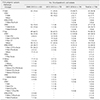1. Baranzoni GM, Fratamico PM, Gangiredla J, Patel I, Bagi LK, Delannoy S, Fach P, Boccia F, Anastasio A, Pepe T. Characterization of Shiga toxin subtypes and virulence genes in porcine Shiga toxin-producing
Escherichia coli. Front Microbiol. 2016; 7:574.



2. Barth S, Schwanitz A, Bauerfeind R. Polymerase chain reaction-based method for the typing of F18 fimbriae and distribution of F18 fimbrial subtypes among porcine Shiga toxin-encoding
Escherichia coli in Germany. J Vet Diagn Invest. 2011; 23:454–464.


3. Blanco M, Lazo L, Blanco JE, Dahbi G, Mora A, López C, González EA, Blanco J. Serotypes, virulence genes, and PFGE patterns of enteropathogenic Escherichia coli isolated from Cuban pigs with diarrhea. Int Microbiol. 2006; 9:53–60.
4. Byun JW, Jung BY, Kim HY, Fairbrother JM, Lee MH, Lee WK. O-serogroups, virulence genes of pathogenic Escherichia coli and Pulsed-field gel electrophoresis (PFGE) patterns of O149 isolates from diarrhoeic piglets in Korea. Vet Med (Praha). 2013; 58:468–476.
5. Byun JW, Jung BY, Kim HY, Fairbrother JM, Lee MH, Lee WK. Real-time PCR for differentiation of F18 variants among enterotoxigenic and Shiga toxin-producing
Escherichia coli from piglets with diarrhoea and oedema disease. Vet J. 2013; 198:538–540.


6. Casewell M, Friis C, Marco E, McMullin P, Phillips I. The European ban on growth-promoting antibiotics and emerging consequences for human and animal health. J Antimicrob Chemother. 2003; 52:159–161.


7. Chae MJ, Cho JK, Lee YJ. Virulence genes of
Escherichia coli isolates from piglets with diarrhea in Korea. J Anim Vet Adv. 2012; 11:9–12.

8. Chen X, Gao S, Jiao X, Liu XF. Prevalence of serogroups and virulence factors of
Escherichia coli strains isolated from pigs with postweaning diarrhoea in eastern China. Vet Microbiol. 2004; 103:13–20.


9. Cheng D, Sun H, Xu J, Gao S. Prevalence of fimbial colonization factors F18ab and F18ac in
Escherichia coli isolates from weaned piglets with edema and/or diarrhea in China. Vet Microbiol. 2005; 110:35–39.


10. Choi C, Cho W, Chung H, Jung T, Kim J, Chae C. Prevalence of the enteroaggregative
Escherichia coli heat-stable enterotoxin 1 (EAST1) gene in isolates in weaned pigs with diarrhea and/or edema disease. Vet Microbiol. 2001; 81:65–71.


11. Duan Q, Yao F, Zhu G. Major virulence factors of enterotoxigenic
Escherichia coli in pigs. Ann Microbiol. 2012; 62:7–14.

12. Fairbrother JM, Gyles CL. Colibacillosis. In : Zimmerman JJ, Karriker LA, Ramirez A, Schwartz KJ, Stevenson GW, editors. Diseases of Swine. 10th ed. Oxford: Wiley-Blackwell;2012. p. 723–749.
13. Fairbrother JM, Nadeau E, Gyles CL.
Escherichia coli in postweaning diarrhea in pigs: an update on bacterial types, pathogenesis, and prevention strategies. Anim Health Res Rev. 2005; 6:17–39.


14. Gyles CL. Fimbriae of Escherichia coli. In : Gyles CL, editor. Escherichia coli in Domestic Animals and Humans. Wallingford: CAB International;1994. p. 399–436.
15. Gyles CL, Fairbrother JM. Escherichia coli. In : Gyles CL, Prescott JF, Songer JG, Thoen CO, editors. Pathogenesis of Bacterial Infections in Animals. 4th ed. Oxford: Wiley-Blackwell;2010. p. 267–308.
16. Ha SK, Choi C, Chae C. Prevalence of a gene encoding adhesin involved in diffuse adherence among
Escherichia coli isolates in pigs with postweaning diarrhea or edema disease. J Vet Diagn Invest. 2003; 15:378–381.


17. Harel J, Lapointe H, Fallara A, Lortie LA, Bigras-Poulin M, Larivière S, Fairbrother JM. Detection of genes for fimbrial antigens and enterotoxins associated with
Escherichia coli serogroups isolated from pigs with diarrhea. J Clin Microbiol. 1991; 29:745–752.



18. Imberechts H, De Greve H, Lintermans P. The pathogenesis of edema disease in pigs. A review. Vet Microbiol. 1992; 31:221–233.


19. Jensen HH, Hayes DJ. Impact of Denmark's ban on antimicrobials for growth promotion. Curr Opin Microbiol. 2014; 19:30–36.


20. Kusumoto M, Hikoda Y, Fujii Y, Murata M, Miyoshi H, Ogura Y, Gotoh Y, Iwata T, Hayashi T, Akiba M. Emergence of a multidrug-resistant Shiga toxin-producing enterotoxigenic
Escherichia coli lineage in diseased swine in Japan. J Clin Microbiol. 2016; 54:1074–1081.



21. Kwon D, Choi C, Jung T, Chung HK, Kim JP, Bae SS, Cho WS, Kim J, Chae C. Genotypic prevalence of the fimbrial adhesins (F4, F5, F6, F41 and F18) and toxins (LT, STa, STb and Stx2e) in
Escherichia coli isolated from postweaning pigs with diarrhoea or oedema disease in Korea. Vet Rec. 2002; 150:35–37.


22. Kwon D, Kim O, Chae C. Prevalence of genotypes for fimbriae and enterotoxins and of O serogroups in
Escherichia coli isolated from diarrheic piglets in Korea. J Vet Diagn Invest. 1999; 11:146–151.


23. Lee JH, Cho HT, Kim YH, Kang HJ, Cha IH. [Isolation of enteropathogenic Escherichia coli, thermophilic Campylobacter and Salmonellae from scouring piglets]. Korean J Vet Res. 1988; 28:67–73. Korean.
24. Luppi A, Gibellini M, Gin T, Vangroenweghe F, Vandenbroucke V, Bauerfeind R, Bonilauri P, Labarque G, Hidalgo Á. Prevalence of virulence factors in enterotoxigenic
Escherichia coli isolated from pigs with post-weaning diarrhoea in Europe. Porcine Health Manag. 2016; 2:20.



25. Noamani BN, Fairbrother JM, Gyles CL. Virulence genes of O149 enterotoxigenic
Escherichia coli from outbreaks of postweaning diarrhea in pigs. Vet Microbiol. 2003; 97:87–101.


26. Pakpour S, Jabaji S, Chénier MR. Frequency of antibiotic resistance in a swine facility 2.5 years after a ban on antibiotics. Microb Ecol. 2012; 63:41–50.


27. Park JY, Shin NR, Park YH, Yoo HS. [Characteristics of Escherichia coli isolated from piglets with diarrhea; antimicrobial susceptibility, genotypes of enterotoxins and pili and plasmid profiles]. Korean J Vet Res. 2000; 40:301–310. Korean.
28. Paul N. Review virulence nature of Escherichia coli in neonatal swine. Online J Anim Feed Res. 2015; 5:169–174.
29. Sato JPH, Takeuti KL, Andrade MR, Koerich PKV, Tagliari V, Bernardi ML, Cardoso MRI, Barcellos DESN. Virulence profiles of enterotoxigenic
Escherichia coli isolated from piglets with post-weaning diarrhea and classification according to fecal consistency. Pesq Vet Bras. 2016; 36:253–257.

30. Zhang W, Zhao M, Ruesch L, Omot A, Francis D. Prevalence of virulence genes in
Escherichia coli strains recently isolated from young pigs with diarrhea in the US. Vet Microbiol. 2007; 123:145–152.









 PDF
PDF ePub
ePub Citation
Citation Print
Print



 XML Download
XML Download